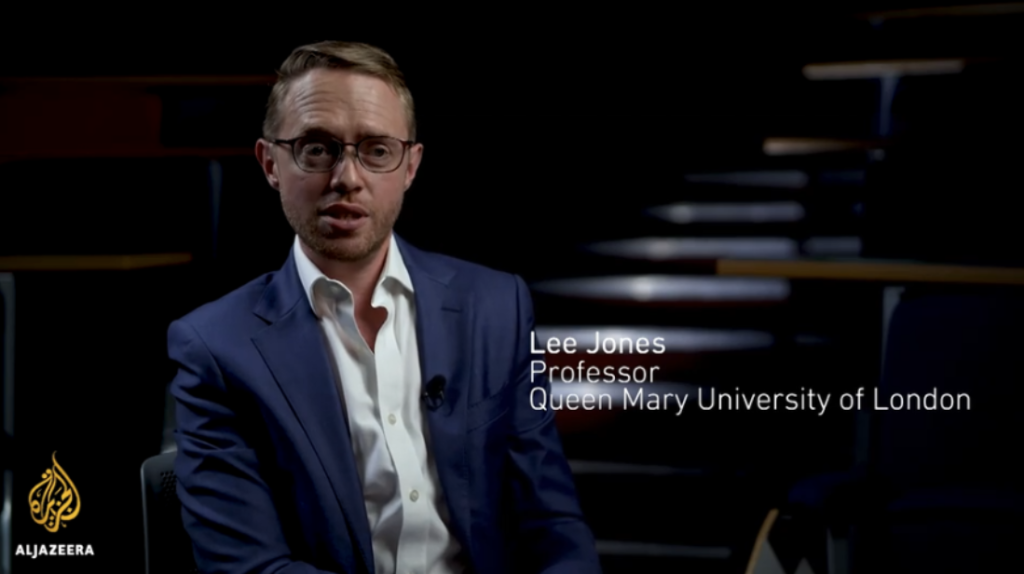How Capable Are the U.S. and Japan of Intervening in a Taiwan Conflict?
Book Review: The Centennial Global Strategy of the United States
- Analysis
 Jiachen Shi
Jiachen Shi- 07/30/2024
- 0
For anyone who wishes to have a grasp of how the Chinese military has perceived the U.S. grand strategy over the past century, I recommend The Centennial Global Strategy of the United States: The Historical Evolution of American Global Hegemony Since World War I (《美国百年全球战略:第一次世界大战以来美国全球霸权的历史演进》) by Dou Guoqing (窦国庆). Published this year, this book provides a comprehensive analysis of the evolution of U.S. military strategy over the last hundred years, considering international conditions, power shifts, and decision-making mechanisms. Dou’s military background provides this book with the potential to serve as a mirror for both China and the United States, which enables each nation to view the other more clearly, revealing overlooked opportunities and hidden dangers.
Dou seeks to understand the intrinsic connections between international relations, war strategy, and military transformation, exploring U.S. diplomacy, crisis response, and foreign warfare patterns. For Chinese readers, especially those interested in the military, this book provides unique insights into America’s development of hard power. Dou’s integration of political psychology personalizes U.S. decision-making, highlighting how perception and misperception are deeply embedded even in the world’s most powerful country. This approach sets an excellent example for Chinese literature on international politics by combining individual, state, and systemic level analyses, vividly illustrating the evolving dynamics of international politics rather than studying it in a static way.
The book not only provides an extensive summary of how the U.S. military has consistently adjusted to the most current geopolitical challenges across technological, managerial, economic, and political dimensions, but also reflects the mainstream opinions held by many Chinese military elites about the U.S. military. Although not all Chinese military elites would be as straightforward in praising the U.S. military as Dou, who states that America has “the capability for military transformation that is difficult for other countries’ armies to follow and emulate” (p. 8), many may agree on at least one point: the pace of innovation within the U.S. military is always remarkable.
For example, Zhu Chenghu, the former dean of National Defense University’s College of Defense Studies, asserted that the United States ushered in the era of modern warfare by being the first to integrate computer and communication technologies, thereby automating various aspects of warfare, including reconnaissance, intelligence transmission, intelligence processing, and command. Chen Bingde, the former chief of the PLA General Staff, was even more explicit in acknowledging the United States as a model for China’s military modernization. He emphasized that U.S. military innovation extends beyond equipment to encompass personnel management, strategic updates, and institutional self-adjustment.
The innovation-driven core of the U.S. military leads to its unique “military culture” (军事文化), as termed by Dou, which fosters a collective identity projecting an image of a unified, efficient force capable of adapting to future warfare challenges. In a nation that highly values culture, the continuity of the U.S. military’s cultural innovation is seen by many Chinese military elites as both a deterrent to potential geopolitical challenges and a model to aspire to for China’s own military.
The book follows a straightforward historical layout. Chapter 1 spans 1914 to 1945, detailing how the United States began to establish its global hegemony by transitioning from isolationism to active international engagement during the World Wars. Chapter 2 delves into the Cold War’s intensification, highlighting the ideological, political, and military confrontations between the United States and the Soviet Union. During this time, U.S. foreign policy shifted significantly toward interventionism, focusing on forming alliances and participating in international organizations to promote democracy and capitalism. Key events, such as the Marshall Plan and the establishment of NATO, are thoroughly described to illustrate U.S. strategic initiatives. This chapter places these efforts in the context of the U.S. aim to bolster its global influence and counter Soviet power.
The U.S.-Soviet power struggle continues in Chapter 3, shifting from direct confrontation to an indirect tug-of-war through proxy wars. During the Vietnam War, the policy of détente temporarily reduced tensions through diplomatic engagement and arms control agreements. However, Ronald Reagan’s administration initiated – a shift toward a more assertive and aggressive foreign policy, involving military buildup and efforts to reshape international norms and institutions in favor of American interests. Chapter 4 examines the United States as the sole superpower in a unipolar world, addressing new challenges such as regional conflicts, the rise of new powers, and globalization complexities. Dou dedicates significant analysis to the U.S. military intervention in the Gulf War, showcasing American modern military power and reaffirming its global leadership role.
Chapter 5 explores the concept of unipolarity, focusing on the U.S. efforts to maintain its status as the sole superpower. It analyzes U.S. military interventions in Afghanistan and Iraq as pivotal elements of its strategy to combat terrorism, assert influence in the Middle East, and demonstrate the evolving nature of its military power. The chapter also addresses new global challenges to the United States in the 21st century, such as terrorism, climate change, and the rise of non-state actors, which have complicated America’s ability to project power and sustain its hegemony. Chapter 6 reviews the historical trajectory of U.S. global hegemony, tracing its evolution from the post-World War II era through the Cold War to the present. It assesses the current state of U.S. hegemony, highlighting both its strengths and vulnerabilities. The chapter also discusses how the U.S. remains a dominant military power but faces challenges from rising powers, economic shifts, and internal divisions.
A notable feature of the book is its extensive use of English sources, including numerous official government documents, which is uncommon in Chinese-language literature. Rather than being a mere literature review, the book is a product of an interplay between a Chinese perspective and English-language sources. Although it leans more towards historical analysis than political science and lacks a dedicated methodology section, it adopts what I would call an “archival ethnography” approach. This method involves deep immersion in governmental documents to identify mechanisms for gathering and processing intelligence. In this book, a rich panoply of governmental documents is carefully analyzed. By presenting archival materials with an ethnographic lens, the book exposes readers to the language used by U.S. state actors to describe their social and political realities. For Chinese readers unfamiliar with U.S. foreign policy, this approach is particularly useful for understanding the evolving dynamics of U.S. decision-making and the interactions between various domestic and international interest groups.
In addition, the extensive use of English-language sources is framed in a way that allows non-English speakers to follow the argument. The book employs a moderate blend of direct and indirect citations from various primary sources, resulting in arguments that are both concise and compelling. Considering the primary audience is Chinese readers, particularly targeting the Chinese military apparatus, the book is presented within a “grand narrative” (宏大叙事) framework. This approach aligns with the Chinese government’s expertise in using grand narratives for domestic propaganda. It makes the book accessible to readers who favor a “fatalistic” (宿命论) storytelling style regarding U.S.-China relations and may also attract Western scholars, such as Graham Allison, whose grand theory of “Thucydides’s Trap” has garnered significant attention in both academic and governmental circles.
However, the exclusive use of English-language sources is not without issues. By focusing on these sources, the book may overlook valuable insights and analyses from Chinese scholars and experts who have studied U.S. strategy and its implications for China. This exclusion can limit the depth of the discussion and the incorporation of diverse viewpoints essential for a comprehensive understanding. For example, in the sections discussing the U.S. response to the Vietnam War and the broader implications of the Domino Theory (p. 86-87), the book primarily draws on Western analyses and perspectives, which often emphasize military strategies and geopolitical calculations. However, it overlooks significant contributions from Chinese scholars who have analyzed these events from a Chinese perspective, focusing on how U.S. actions affected China’s own security concerns and its subsequent foreign policy decisions.
In addition, the reductionist approach in the book – focusing almost exclusively on U.S. military power – leads to a lack of in-depth analysis of the broader diplomatic, economic, and social factors that shape U.S. global strategy. Although the book purports to address how internal political, economic, technological, and cultural factors create diverse tensions and influence U.S. foreign behavior, I found the analysis of these non-military aspects lacking. The coverage of these factors fails to adequately explore the causal mechanisms behind their impact on U.S. foreign policy, rendering their treatment somewhat superficial and merely decorative.
For example, when discussing the domestic pressures Woodrow Wilson faced in seeking Senate ratification of the Covenant of the League of Nations to facilitate U.S. entry into his proposed League of Nations (p. 22-23), Dou merely recapitulates the event in a manner that mirrors existing literature. He could have deepened the analysis by exploring the personal and ideological conflicts between Wilson and Senate Majority Leader Henry Cabot Lodge, who led the Republican opposition and championed isolationism and American sovereignty. Alternatively, a comparative analysis between Wilson’s failure to get the U.S. involved with the League of Nations and Franklin Roosevelt’s success in founding the United Nations could have highlighted how U.S. foreign policy, often perceived as separate from domestic politics, remains deeply influenced by internal political dynamics. The partisan divisions that hindered Wilson contrasted sharply with the bipartisan support that facilitated Roosevelt’s success. I believe that if the book had incorporated more comparative cases, similar to Henry Kissinger’s approach in his book American Foreign Policy, its arguments could have been more robust and persuasive.
The book’s overemphasis on the military dimension and its minimization of domestic politics highlights another significant shortcoming: the oversimplification of causal mechanism often leads to arguments being presented out of context, potentially causing logical incoherence. While domestic politics are briefly mentioned, Dou downplays their significance to the extent that readers might come to believe geopolitical concerns are the primary factors driving U.S. policymakers. Consequently, the already limited discussion of internal factors affecting U.S. foreign policy often seems out of context, resulting in confusion. For instance, the book briefly describes the Neutrality Acts with the statement, “The Neutrality Acts reflect the premonition and anxiety about war” (《中立法案》反映出对战争的预感与忧虑) (p. 32). This brief description in Chinese not only fails to acknowledge that the Neutrality Acts were a series of legislative measures but also overlooks their role as a product of isolationism – a powerful sentiment in America throughout the 1930s aimed at restricting the president’s ability to engage in foreign military conflicts in Europe and beyond. The terms “premonition” and “anxiety,” used in the book to describe the nature of the neutrality laws, leave readers inadequately informed without proper contextualization.
My last critique stemming from the book’s overemphasis on the military dimension is its omission of critical periods between significant junctures, which results in a lack of nuanced understanding of the gradual evolution of U.S. grand strategy, both militarily and ideologically. For instance, the book overlooks the gap between the 1986 Maritime Strategy under the Reagan administration and the consolidation of U.S. hegemony following the Gulf War and the collapse of communism in Europe. This omission misses a crucial implication of America’s soft power: how its effort to build the liberal international order led to the democratic diffusion and ideological erosion in Central and Eastern Europe during the American-led wave of democratization between 1970 and 1990. The author could have dedicated more of the book to discussing how U.S. hard power and soft power complement each other.
Overall, Dou’s book is valuable for those interested in the U.S. grand strategy from a military perspective. Although the book’s emphasis on military aspects may attract criticism for overlooking the broader diplomatic, economic, and social factors shaping U.S. global strategy, this focus is understandable given the author’s military background. Revising the title to emphasize the military aspect could better position the book and provide readers with a clearer understanding of its focus.
Despite these limitations, the book remains a must-read for Chinese readers as it objectively explores how the U.S. maintains its military, diplomatic, and economic supremacy, moving away from the traditional Marxist analytical framework. As China continues to rise as a global power, understanding the historical context of U.S. hegemony and its implications for international relations is vital. The book offers valuable insights into how the U.S. has navigated various geopolitical challenges, which can inform China’s approach to its own regional and global ambitions, especially given the increasing tensions in the Taiwan Strait and the South China Sea.
Jiachen Shi is a Ph.D. candidate in Political Science at Tulane University and a former intern for The Carter Center’s China Focus program.







